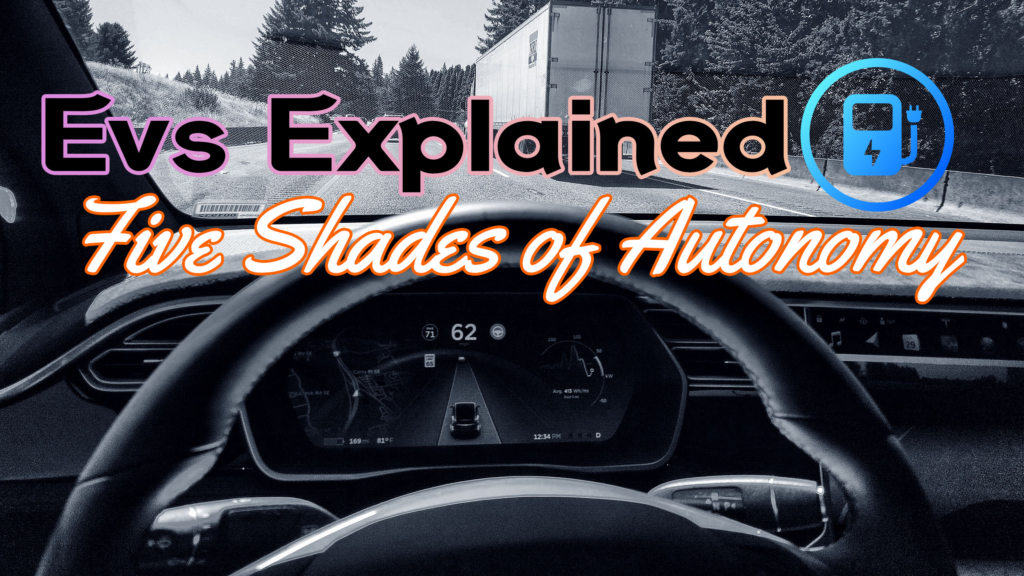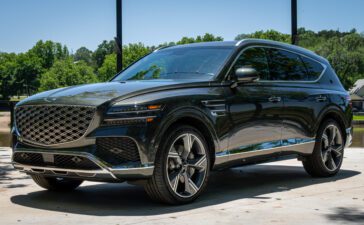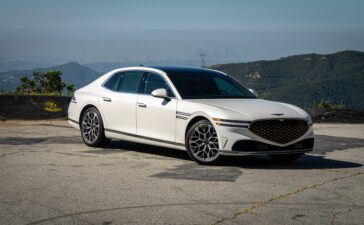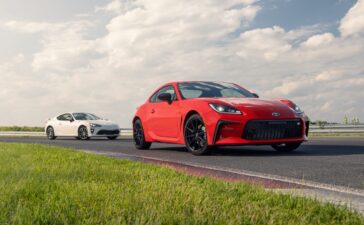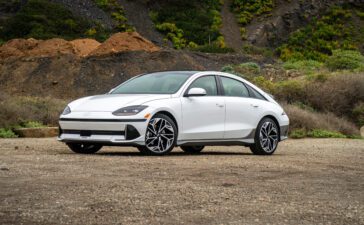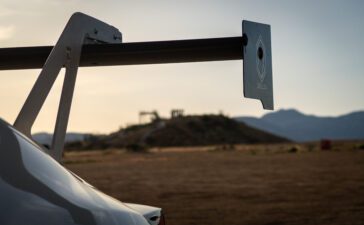Hello again! No need for the triple-shot espresso and the phonebook-sized notepad, as today’s chapter of EVs Explained will be far more straightforward – I hope. Today’s field trip is through the ascending levels of autonomous driving and what goes into these purported self-driving cars. Let’s talk about what really defines each level of vehicle autonomy, what tech goes into them, and what examples of modern cars use such new-age technology.
Love or hate it, we’re entering a bold new world of strong independent vehicles that “don’t need no damn human,” and we’re peeking at what makes them tick. Or rather drive.
Not so autonomous, not always electric.
Disclaimers before we kick off this first segment!
Take the use of “self-driving” and “autonomous cars” with a grain of salt, and treat them as umbrella terms. Oftentimes, such words just describe safety assists that aid in hustling you from Point A to Point B safely and conveniently. Many instances of what are considered levels of vehicle autonomy aren’t all that autonomous but more like watchful eyes, with the ratio of human-to-machine intervention shifting as we climb the ladder and add copious amounts of gadgets.
Also, note that autonomous driving doesn’t solely encompass EVs. In fact, much of the tech used in self-driving cars debuted in ICE cars. But it’s becoming the more prominent medium through which automakers unveil these crown achievements because nothing says future more than everything-by-wire, spaceship noises, and range anxiety.
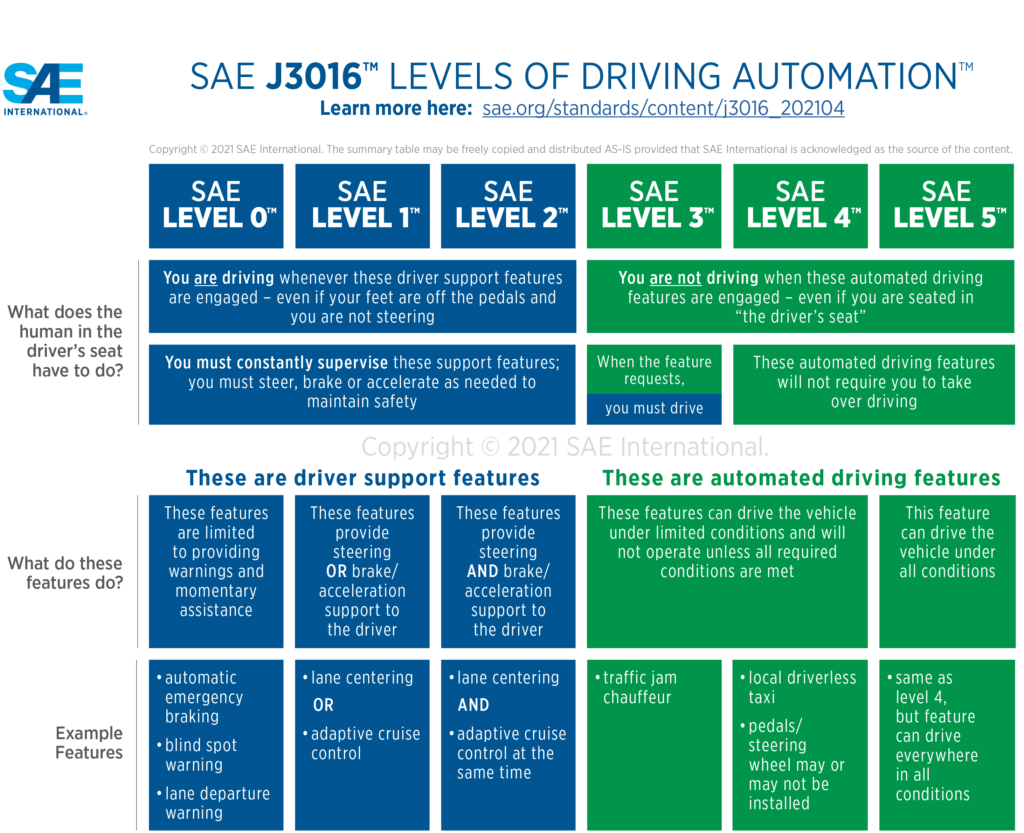
Level 1: Driver assistance
The first stage in achieving autonomy is clearing that Level 1 hurdle, defined as semi-autonomous driver assistance that merely shares control with the driver and only to a mild extent. The electronic doo-dads exist as extra hands on deck, but you are still the ship’s captain. They’re helpers, guides, and advisors but ultimately cannot take full command. Examples include adaptive cruise control, parallel park, lane keep assist, and other useful gizmos along those lines, typically things that function off relatively basic camera and sensor-based systems.
Such gadgets have become commonplace in ordinary econoboxes over the past several years. For example, my dad’s mid-trim 2017 Toyota Tacoma had lane keep and adaptive cruise. And to be honest, they worked pretty damn well! Today, brands like Toyota and Subaru pride themselves on standard or easily available Level 1 systems like Safety Sense and Eyesight, respectively. More than a sales pitch, these systems are rapidly entering normality, now touted in just about anything, from top-shelf Mercedes and BMWs to Ford Mustangs and Subaru BRZs
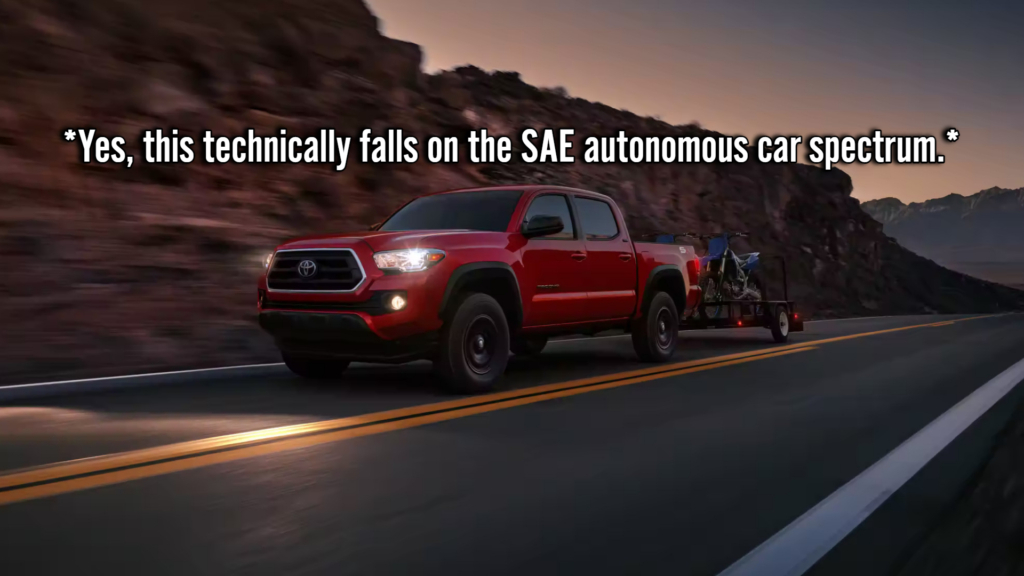
Level 2: Partial automation
The next step sees improved competence with acceleration, steering, and braking based on integrated safety systems. Level 2 cars can follow lanes, come to complete stops, and accelerate to fairly lofty highway speeds. As such, Level 2 is informally dubbed a “hands-free” system. However, it’s important to know you shouldn’t take that literally, and company disclaimers will advise that drivers keep their hands on the wheel or at least be ready to resume control like a responsible adult. For instance, although the Acura Integra Type-S and MDX Type-S I previously sampled were not Level 2 cars, they did have self-lane-centering tech that almost felt as though the car could drive itself, but it’d always flash a warning at the driver every several seconds or so to return your hands to the wheel.
Oftentimes, these systems won’t take highway exits or traverse parking garages on your behalf, although some cars may be programmed to try some of those actions under your supervision. Many will at least initiate lane changes to pass slower traffic, which is kind of them. Helping guide Level 2 cars is a task that can call upon an assortment of visual cameras, radars, and other sensors to help navigate.
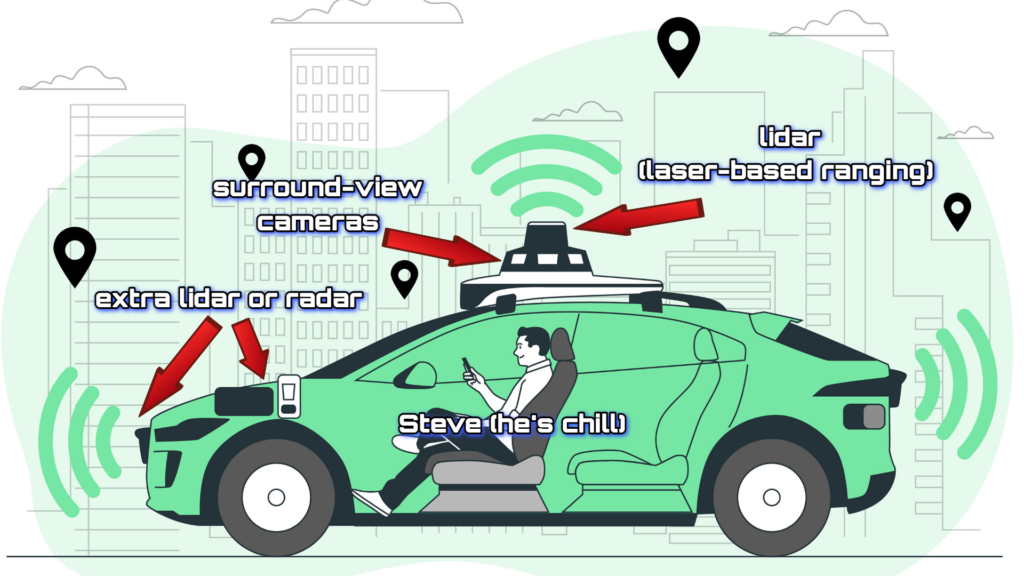
By SAE and NHTSA standards, Tesla’s Autopilot is a prime example of Level 2, as is GM Super Cruise and Ford BlueCruise. Cars such as the F-150 Lightning made BlueCruise famous following that truck’s expansive media coverage, as did the Cadillac CT6, Escalade, and Chevrolet Silverado for Super Cruise. Both Detroit-born systems have exponentially enhanced steering, braking, and adaptive cruise abilities beyond plain adaptive cruise control, arguably trumping Tesla Autopilot thanks to the added use of lidar, a.k.a. laser-based ranging, and GPS data. However, Tesla’s Navigate on Autopilot (a feature of Enhanced Autopilot but not Full Self-Driving) isn’t as restricted and can be activated in many off-highway locations, far outside the reach of Ford and GM, even taking highway exits should the system find it feasible at the moment.
However, engineers place parameters to encourage driver intervention in the name of occupant safety and avoiding lawsuits. That first point is totally more important to the corporate suits, by the way. Such parameters often include geofencing and cameras that trace your head and eye positions to determine driver attentiveness.
Or, when all else fails, they can just blame it on you. Sounds like my parents.

Level 3: Conditional automation
Behold the goalpost where many automakers strive to land, but only a few have hit the mark. NHTSA defines Level 3 as real self-driving, the point where the driving aid systems can take complete control of the vehicle. This fabled new height in technology expands upon the car’s newfound ability to steer, brake, and accelerate but does so across more environments and with more liberty, theoretically allowing these cars to embark on complete journeys independently. Of course, “independently” for Level 3 still means laying watchful eyes and being ready to shut down any robot-uprising nonsense.
Although many debate the true abilities of Tesla’s Full-Self Driving, I argue it could be touted as Level 3 autonomy, expanding heavily upon Autopilot. It certainly scoots from place to place, even if it has a taste for mortal blood, and tends to sail into its fellow machines from time to time. But alas, as of late December of 2023, it’s not SAE-certified as such. Being the first certified Level 3 autonomous cars in any U.S. state is an honor bestowed to the Mercedes-Benz S-Class and EQS and their Drive Pilot system, even if it’s only in limited locations.
Impressive! But once again, I iterate that automakers necessitate driver overwatch, and the mighty Three-Pointed Star is no exception, even after earning its Good Noodle Star over its peers.
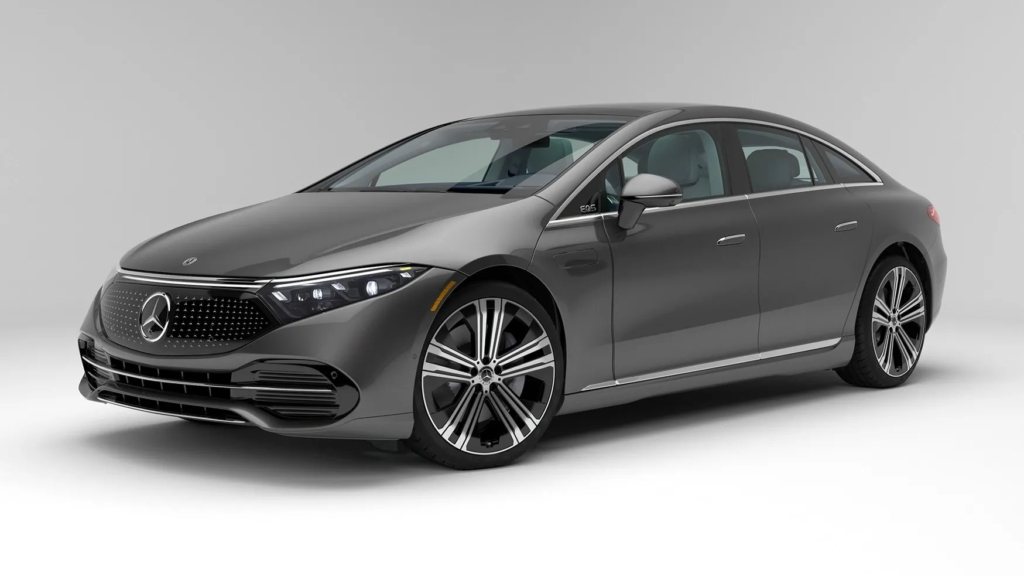
Level 4: High automation
Careful, Icarus. Now we’re really flying high.
NHTSA defines Level 4 as a system where the car can command all aspects of driving to a point where human intervention is not always necessitated. The overarching Achilles’ heel connecting Level 4 to Level 2 and Level 3 is that they’re all limited to operating within certain boundaries, unable to drive on all roads or in all weather conditions without human backup. A Level 4 system can be geofenced or kept from activating in certain situations akin to lower-tier systems such as Super Cruise or BlueCruise, but it stands taller with greater control and refinement.
In essence, it can do more within a larger playpen and even correct mistakes without our help instead of self-canceling. That latter point is a major differentiator and why some companies opt to dive straight into Level 4 development rather than work on Level 3.
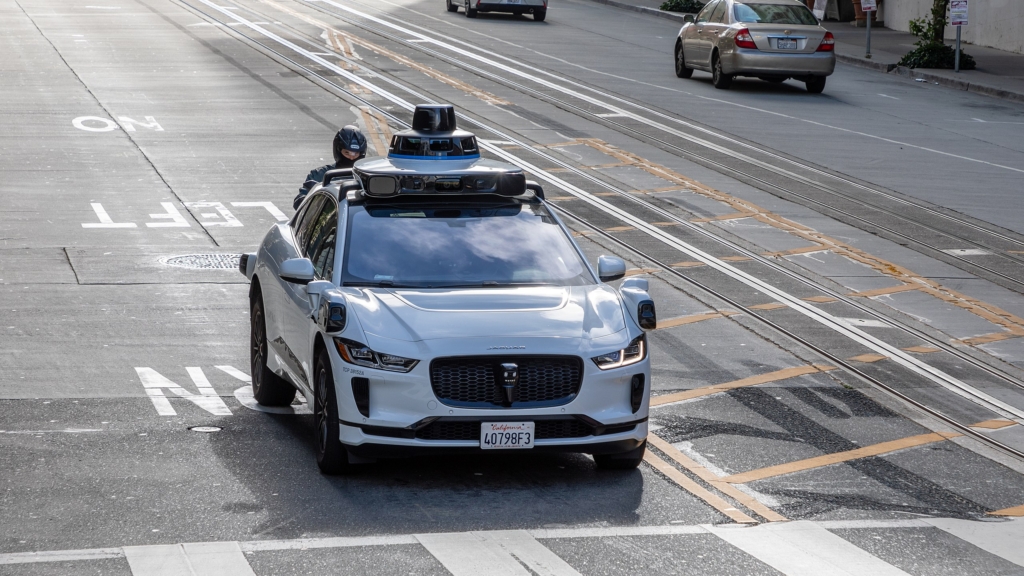
So those pesky Germans may have beaten Elon’s fleet to Level 3 certification. But certainly, Level 4 is in the bag. Or so they’d think. Or so anyone would think, as Level 4 stands as the next big power play, with no current production cars certified for such technology. However, there being no certified vehicles doesn’t mean they’re not testing. And with all the work automakers put in to barely attain Level 2 and Level 3 certs, they’re being quite frank in saying it’d be a while until they set anything in stone. Mercedes claims the technology is “doable” by 2030, and Hyundai is currently testing Level 4 with Ioniq 5 mules.
Technically, if we’re counting any company and not just legacy automakers, Google’s Waymo project, now partnered with Uber, operates off what’s technically Level 4 autonomy. Their vehicles have been testing and operating as robo taxis in select cities for some time, seeing their fair share of successes and disasters in the process.
Level 5: Full automation
‘Tis the king of the hill that all auto manufacturers strive for, the stuff of video game fever dreams and sci-fi movie fantasies. Queue our inner Doug DeMuro voice.
“THIS… is a true, fully self-driving car. “
Level 5 is defined as full automation or, as NHTSA paraphrases, “–system drives, you ride.” Here lies uninhibited vehicle autonomy with the most liberal use of self-driving functions, intended to be the ultimate riding experience for occupants. Manual controls are redundant, and driver attention monitors are banished to irrelevancy. The lack of restrictions, such as geofencing, separates Level 5 from the overprotective mom, called Level 4. This highest tier of autonomous vehicles leaves the nest to achieve true self-driving in nearly any condition and on any road. Human intervention is no longer necessary.
As you can imagine, nothing outside of Cyberpunk or Watch Dogs is certified as Level 5 autonomous, and reaching this realm will take a great deal of testing, refinement, and failsafe after failsafe. Those sci-fi visions of cars navigating gridlock without steering wheels or pedals are utopian examples of what a Level 5 car can be, and programming such cars to properly respond to every little variable in real-world driving will be a hell of a feat. But an engineer can dream. And should technology press on at the rate it’s going, it’s not a far-fetched delusion to believe Level 5 will be within our grasp. But I’ll give it until 2077.
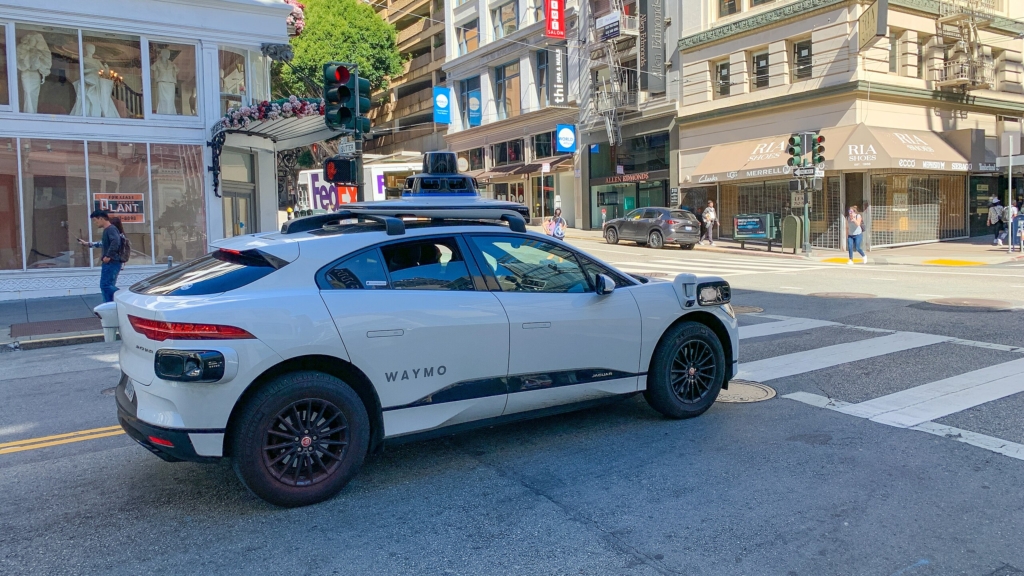
Gather our eggs into one robo taxi.
Let’s take it from the top. Or rather, the bottom.
Level 1 is just boujee driver assistance. It’s a fairly basic and common system nowadays, imbuing many new cars with helpful nannies, including parking assist, adaptive cruise, lane keeping, and more. To learn more, please pester your local Toyota salesman. No, seriously.
Level 2 refers to additional driver assistance by way of enhanced control over acceleration, braking, and steering. Not unrestricted, but it can take a huge load off your commute when under your watch. Many major car companies have introduced or have started introducing such systems, with Tesla’s Autopilot perhaps being the most famous (or infamous) of them all.
Level 3 equates to conditional automation, meaning the car can control itself to an even greater extent. Highway traversing or some urban jaunts are a non-issue for Level 3, so long as the driver is always at the ready to take back the helm when needed. Few cars taut Level 3, and even fewer are SAE-certified for it.
Level 4 cars can almost care for themselves within reason and operate under a fairly strict set of parameters and in select environments. As such, drivers are optional but unnecessary, but manual control is always there as a safety net. Manufacturer testers and robo-taxi companies are currently fielding such tech.
Level 5 stands as the magnum opus autonomous vehicle engineers seek to create, a fully self-driving car with no limitations as to where it can go, completely writing the driver out of the equation.

It makes your head spin to think how far we’ve come, huh? From parking sensors to self-driving taxis parading the streets of major cities. Yes, as I’m sure you can infer by my subtle jabs, there’s no denying this is highly controversial and dangerous tech and certainly an injury lawyer’s dream come true. And sure, some manufacturers are far better at testing than others. But it’s admirable how all strive to tame this riveting new frontier, the stuff of childhood curiosity. The skepticism it sparked is well-deserved, but witnessing how this technology evolves as we lean deeper into the automotive industry’s most polarizing era incites just as much excitement.

